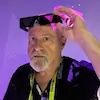
Welcome back to Spatial Beats, where we round up all the top news and happenings from around the spatial computing spectrum, including its escalating infusions with AI and other emerging tech. Let’s dive in…
The Lede
Open AI Sued by Eight More Media Companies. Several weeks ago the NY Times revealed numerous tech companies ignored firewalls and deliberately broke copyright law when building their AI. Tuesday, Eight daily newspapers owned by Alden Global Capital, the second largest newspaper chain in the US (holdings include The New York Daily News, and Chicago Tribune) sued OpenAI and Microsoft. The Adlen companies said the chatbots regularly surfaced the entire text of articles behind subscription paywalls. It could take more than five years for these claims to work their way through the courts. Open AI has some powerful arguments, notably fair use, and public good, but even if they were sanctioned, lets say more than any company in history, they could easily afford a multi-billion dollar fine. For this reason, some publishers, like Le Monde and Alex Springer, have opted to make deals with OpenAI instead.
The AI Desk
Meet Vidu from China, Sora’s Extraordinary New Competitor. Developed by Tsinghua University and Chinese AI firm ShengShu Technology, Vidu is China’s first text-to-video generator. It has the ability to generate videos as long as sixteen seconds. Since the LLM model developed in China, it has a China-first view of the world. Not sure how or when it will be available to users in the West.
Chat GPT Now Remembers. This feature allows ChatGPT to remember details across multiple interactions, such as your daughter’s obsession with Minnie Mouse or a PowerPoint presentation you need to upload every time you want to ask a question, making it a more useful assistant. The memory function is now accessible to ChatGPT Plus users. To save a detail, you can instruct ChatGPT with “remember this …” You can also prompt ChatGPT to retrieve any stored memory. Users have full control over your stored information: you can enable, reset, or delete specific memories or all memories as needed.
Paul Trillo’s new Sora-produced music video for the band Washed Out, The Hardest Part, is the first commercial music video made with OpenAI’s Sora. The filmmaker said it took 700 generations to create the 55 selected clips. “This was an idea I had almost 10 years ago and then abandoned,” said Trillo. “With Sora, I was finally able to bring it to life.” Trillo also created this remarkable vision of the future of the TED conference to open AI day at the show.
Filmmaker Jordan Ray Allen describes himself as “an eclectic artist/retro-enthusiast.” He is a huge admirer of Quentin Tarantino, and since the great filmmaker retires after his 10th film, Allen decided to pay homage by revisiting the character of Jules from Pulp Fiction. “I wanted to be brought up to speed on the retired hitman who left it all behind to walk the earth in search of redemption,” said Allen. “Pretty much, Kung Fu meets The Book of Eli.” Tools used (partial list): Images and animation Runway (Gen 2), Narration from Play HT (1.0), DaVinci Resolve to lend to the cinematic aesthetic.
Will An AI Movie Win An Oscar Within 7 Years? Will Hollywood embrace AI, fight it, or ignore it? The Academy Award as a proxy for acceptance.
Hardware is Hard
Rabbit R1 “Barely Reviewable” says Marques Brownlee in his brutal YouTube takedown. Controversy and harsh reviews have followed the release of The Rabbit R1, which created quite the buzz at CES in January. They’ve sold over 100,000 of $199 version 1 of their portable all-in-one AI assistant, which just shipped. The device was supposed to be the anti-smartphone, running all your apps in the cloud. Mishaal Rahman of Android Authority reproduced the R1 experience on an Android phone, concluding it should be an app. Rabbit CEO Jesse Lyu says the Rabbit R1 involves more complex integration with bespoke firmware and cloud services, which aren’t fully replicable on other devices. The broader critique of the R1 focuses on its limited functionality. Few would (or should) leave their smartphones behind. Who needs a second device? I have many AI apps on my phone already.
Feeling Spatial
- Snapchat launches new AR and ML tools for brands and advertisers
- Blippbuilder Mobile brings AR content creation to mobile devices
- Former Oculus CTO: Don’t Expect Cheaper VR Headsets Than Quest After Horizon OS Release
- Apple Vision Pro to Optimise iPhone, iPad Cross-Compatibility
- New Unity 6 Feature Makes it Easier for XR Devs to Maximize Text & UI Quality
- Smartphones will be obsolete in 10 years, says Meta’s AI Chief
- Meta’s Head of AR Hardware Teases Next-gen Transparent AR Glasses with Wide Field-of-view
- Google has made it really hard to find its 3D animals in Search
Weekend Reading
Marc Andreessen Is A Maniac (Gizmodo)
Listen In
For more spatial commentary & insights, check out This Week in XR, hosted by the author of this column, along with Paramount’s Futurist Ted Schilowitz, and Magic Leap founder Rony Abovitz. This week our guests are Jennifer Tuft and Cassandra Rosenthal, Co-CEOs and founders of Kaleidoco. You can find it on podcasting platforms Spotify, iTunes, and YouTube.
 Charlie Fink is an author and futurist focused on spatial computing. See his books here. Spatial Beats contains insights and inputs from Fink’s collaborators including Paramount Pictures futurist Ted Shilowitz.
Charlie Fink is an author and futurist focused on spatial computing. See his books here. Spatial Beats contains insights and inputs from Fink’s collaborators including Paramount Pictures futurist Ted Shilowitz.






